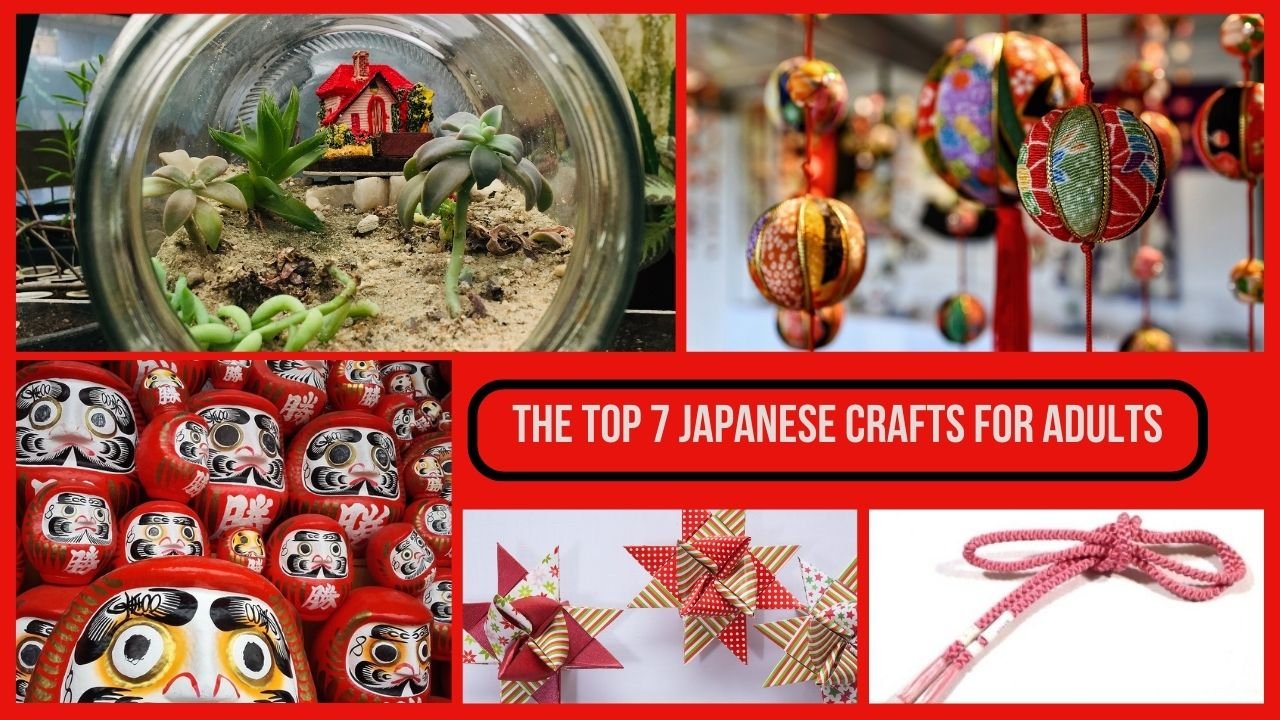There’s magic in making things. Something therapeutic too. Youngsters are introduced to crafts at a young age, then like us, technology takes over our lives. Japanese crafts for adults lets you get off the screen, and really immerse yourself in the soothing world of craft projects.
Delve into the Top 7 Japanese Crafts for Adults to Truly Unwind
1. Design Your Own DIY Mini Zen Garden (Penjing)

A popular hobbycraft emerging from Japan is Bonsai. It’s an art form of imitating tree life in miniature form. Penjing does the same, only it’s entire landscaped gardens in miniature form. A DIY mini zen garden for a better way to think of it.
DIY mini zen gardens are small-scale terrains made to resemble a garden, but used as home décor, and they’re super handy for mindfulness and meditation. You can create your own with simple items, such as a decorative tray, clay planter, or simply a container with enough depth to add a layer of soil or sand, some pebbles, and decorative miniatures. That’s all you need to pull this off. A glass jar can be used to create a garden inside a terrarium too.
To give your mini zen garden an authentic Japanese vibe, use real mini plants. Succulents and cacti are absolutely HUGE in Japan. Swap the soil for sand and get a mini zen rake for something super artsy with an astounding calming effect. You could spend hours drawing shapes and patterns in the sand, and wiping it blank to start again. A bit like a zen-like Etch-a-Sketch.
Better yet, it’s never really a one-and-done project. Just like your garden, you have the freedom to change by the season. Swap the summer vibe of sand for the base for white sand or even flour to mimic snow.
Mini gardens don’t need to be zen like either. For meditation, you could include a miniature buddha statue, but if you want something traditional perhaps to remember a trip to a specific area of Japan, Kokeshi dolls could be the addition for ultimate personalization.
Did you know that there’s different types of Kokeshi dolls? 12 in total, each with designs unique to different regions.
-
Use Origami to Create Intricate Designs with Paper Folding

It’s no surprise that Japan holds the world record for the largest origami creation. Consisting of 6,110 origami flowers created by all six grades of Mouri Elementary School in Koto, Tokyo, Japan. As a Japanese craft, origami reigns supreme. It’s the ultimate classic and it’s far more than paper folding.
There are 3 types of origami. Single sheet, modular, and composite. Designs range from simple for beginners, to extremely complex origami projects for competitive adults.
The most difficult is believed to be the crane, however, enthusiasts have thrown down the gauntlet on that. You’ll find extremely intricate designs ranging from dragons to duelling knights that have been hand-folded over a hundred times with a single sheet of paper. You don’t need to stick to the rules either.
Traditional origami involves folding paper only. No Glue, tape, and scissors are used. If you want to make your crafts easier and more vibrant, call it paper craft. You can create 3D visual illusions by constructing origami shapes and sticking those together like a mosaic puzzle.
-
Immerse Yourself in the Needlepoint Craft of Temari

The word ‘temari’ in Japanese means ‘handball’. It’s a blend of needlecraft and embroidery and a symbol of friendship and loyalty. In modern-day Japan, adults make these to gift to youngsters on New Year’s Day to symbolize hope for the year ahead.
Traditionally, mothers would write a love message, like what they wish for the child in the New Year, and wrap that inside the ball. Another option is to wrap a bell inside it to symbolize good luck. Around the world though, the geometric designs of thread balls are a creative Japanese craft for adults who enjoy needlepoint projects.
Temari balls can be used as home décor on bookshelves, as hanging decorations for the Christmas tree, or hung from the ceiling like a wind chime. They’re also used as fashion accessories by attaching them to keychains, phone cases, backpacks, handbags, and purses.
-
Take Up Kumihimo: A Unique Form of Japanese Braiding

Ichiro Wada, CC BY-SA 3.0 CZ, via Wikimedia Commons
Kumihimo is traditional Japanese braiding. There is so much you can create with a simplistic kumihimo disc and some threads, cotton, or wool. If you’re familiar with friendship bracelets, that’s the basics of kumihimo.
It’s taking a disc and weaving threads up and down, rotating the disc, and repeatedly braiding to easily create complex-looking cords. Use those for trims around photo frames, curtain tiebacks, or handmade braided bookmarks. That’s just with textiles. You can also do kumihimo beading, which is jewelry making. Bracelets and even earrings can be made with the same Japanese braiding technique for a truly personal touch.
-
Make Your Own Lucky and Charming Looking Daruma Dolls

Daruma dolls are iconic in Japanese culture. Constructed out of simple papier mâché (paper mache), they’re painted in striking red, and gold colors. Apart from the eyes. The eyes remain unpainted until you set a goal. When you set a goal, you make that your wish and you paint one eye when you set that goal. Then when your goal's fulfilled, you paint the other eye.
Daruma dolls are good luck charms. You can make these as small as an egg or as large as a balloon. You only need the head because these dolls, like Kakeshi dolls, don’t have arms, or legs. It’s the head only. Once the papier mâché is set, sketch the outline for the face and paint the entire thing. Traditionally, they are painted red, and that’s because red symbols good luck in Japan.
-
Shoda: Practice the Art of Japanese Caligraphy

If you felt learning to write English was hard, have a try at writing in Japanese. There are three languages. Kanji, hiragana, and katakana. Kanji is used for singular words being carried over from the Chinese language. Hiragana and katakana are syllable-based.
There are thousands of Kanji characters, but only 46 each for hiragana and katakana. Yet, you need all three to form a sentence. Don’t let that stop you though. Shodo isn’t all about writing. It’s Japanese calligraphy. The art of portraying the complex language in an art form through the strokes of your paintbrush, or calligraphy ink sets.
Using only black ink, you can create monochrome artwork where only one color is used (typically black ink on white paper), or go with polychrome shodo where each character drawn or painted uses a different color. With a mixture of styles and colors, you could be creating triptych wall art displays with one syllable per drawing arranged in sets of three.
-
Use Dioramas to Build Your Own Mini City on a Shelf

Japan is a haven for all things miniature. The unique characteristics of the scenery, the vibrant lighting, the musings as you visit many of the cities around the country, there’s just so much to encapsulate.
The best way to capture everything is to put it into a Tokyo DIY book nook kit that has honed in on everything the city has to offer. From the ramen bar scenes, vibrant alleys that are perfectly illuminated in Japanese lanterns, fish markets, scenic apartments, and of course, the signature Japanese caligraphy for signage above shops.
3D puzzles make building your own dioramas super simple. The instructions included walk you through the assembly steps just like a tour guide of Tokyo city! Being miniatures, building your own book nook is a Japanese craft for adults rather than a puzzle for kids. The age recommendation is for 14 years and up.
Once assembled, these make terrific displays on a bookshelf (or any shelf), adding to the mystique and inviting you into the authentic culture each miniature city reverbrates each time you look at the bookshelf insert.




Share:
Your Ultimate Guide to DIY Book Nook Kits
Best Japanese Gifts for Bookworms to Reminisce on Travels